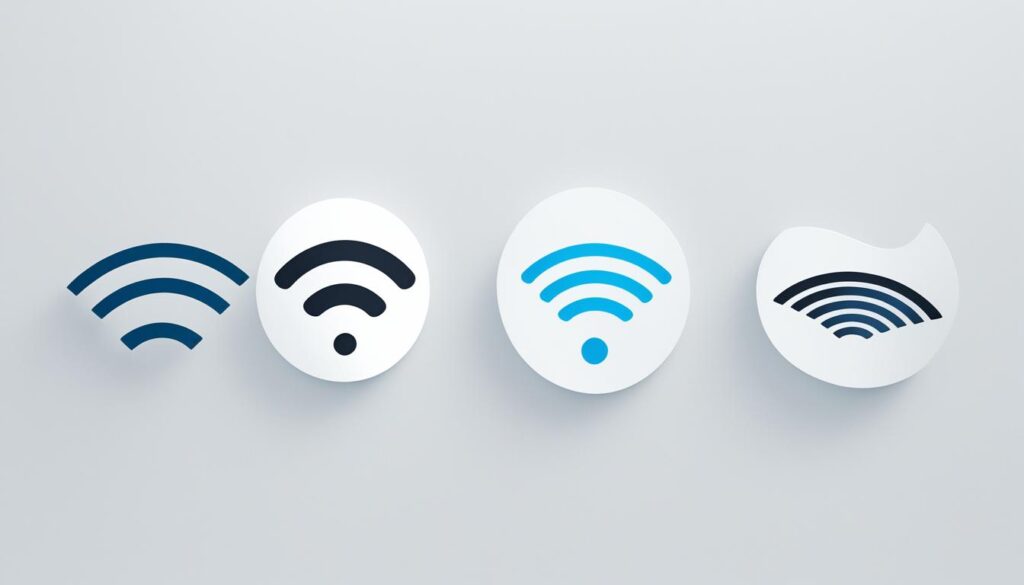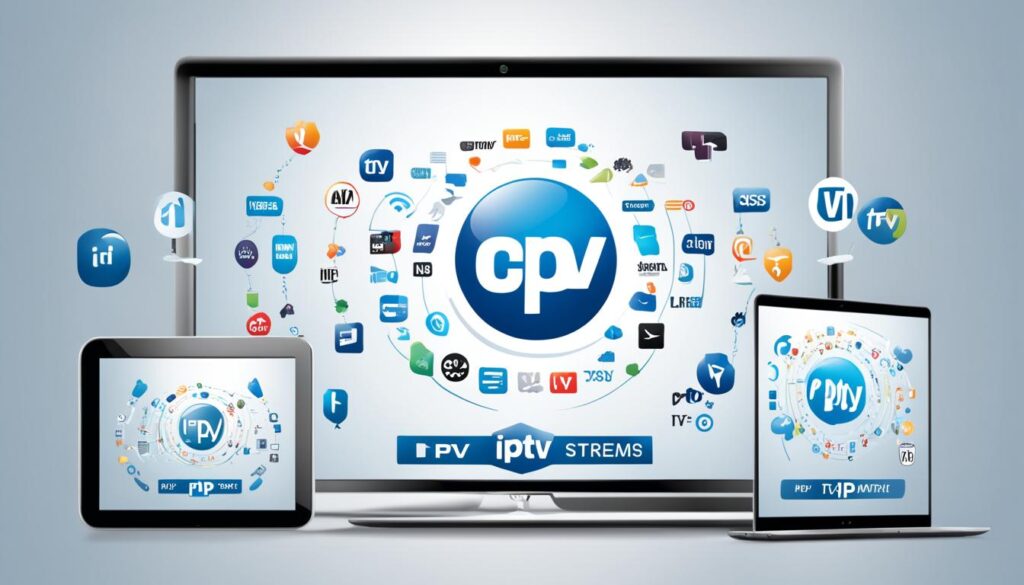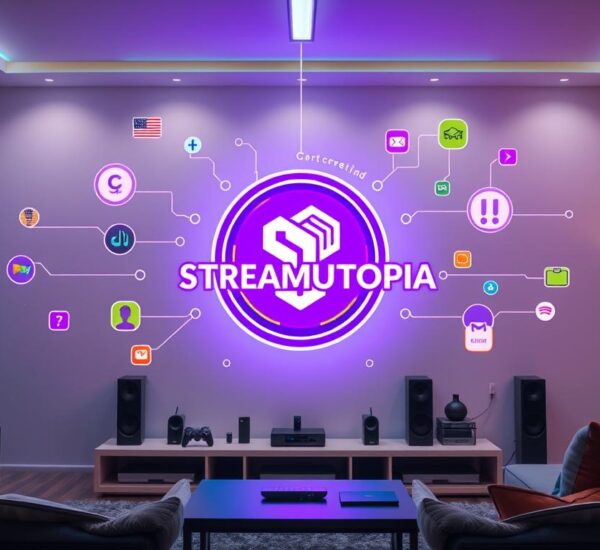Did you know that more and more people are using IPTV (Internet Protocol Television) these days? It’s becoming a big deal. IPTV is set to grow to $117.07 billion by 2027. This growth is thanks to a yearly increase of 13.7% from 2020 to 2027.
When you stream shows on services like Netflix, Hulu, Amazon Prime Video, and YouTube TV, your internet matters. With a good internet connection, you can watch HD or even 4K content smoothly. This makes your streaming experience much better.
Key Takeaways
- 1. IPTV is projected to reach a global market size of $117.07 billion by 2027.
- 2. Optimizing your internet connection is crucial for a smooth IPTV streaming experience.
- 3. Popular IPTV services include Netflix, Hulu, Amazon Prime Video, and YouTube TV.
- 4. Factors like bandwidth and network latency can impact IPTV streaming performance.
- 5. Through proper optimization of your internet and network infrastructure, you can enhance your IPTV viewing experience.
What is IPTV?
If you love streaming movies, TV shows, and sports, then IPTV is not new to you. IPTV is short for Internet Protocol Television. It’s a way to watch TV over the internet. Unlike cable or satellite TV, IPTV uses internet protocols to send shows to your devices.
So, how is IPTV different from regular TV? Well, it’s all about how you get the shows. Instead of using cables or a dish, you use your internet connection. This lets you watch shows and events from all over the world, if you have internet.
Now, there are many IPTV services out there. They all aim to please different tastes and needs. Let’s highlight some top ones:
- Netflix: It’s loved for its huge offering of movies, TV shows, and original series. It’s a must for many viewers globally.
- Hulu: If you like a mix of new and classic shows, Hulu is perfect. It’s especially popular with those who’ve said no to cable.
- Amazon Prime Video: With an Amazon Prime subscription, you get Prime Video. It includes a wide range of movies and shows, plus exclusive content.
- YouTube TV: A choice for those who love live TV. It gives access to many channels and sports events live.
These are just a few examples of what you can find. Every service has its own shows and features. This makes it easier to find what suits you best.
Comparison of Popular IPTV Services
| Service | Features | Price |
|---|---|---|
| Netflix | Extensive library of movies and TV shows, original content | $8.99 – $17.99 per month |
| Hulu | Mix of current TV shows, classic series, original content | $5.99 – $11.99 per month |
| Amazon Prime Video | Diverse range of movies, TV shows, exclusive content | $8.99 per month (included with Amazon Prime subscription) |
| YouTube TV | Wide selection of channels, live sports events | $64.99 per month |
Every IPTV service has its own good points and costs. It’s vital to check what’s out there and find the best match for you. Both for your viewing needs and your budget.
Factors Affecting IPTV Streaming Performance
Smooth and continuous IPTV streaming is key for a good experience. To ensure this, we must look at several factors that influence IPTV performance.
Bandwidth and Internet Speed
Having enough bandwidth and a fast internet is crucial for watching IPTV without buffering. A higher bandwidth supports better video quality and less pauses.
For HD streaming, you’ll need at least 5 Mbps. But to enjoy 4K Ultra HD without hiccups, you should aim for 25 Mbps or more.
Network Latency
Network latency means there’s a delay as data moves from one point to another. This can lead to buffering, frozen screens, or low-quality images.
Reducing network latency is important. Choosing an ISP known for fast connections can help. Also, using a cable connection instead of Wi-Fi can cut down on delays.

Optimizing Your Home Network Infrastructure
Optimizing your internet for streaming is key. A stable network is crucial for seamless IPTV. Let’s look at how to make your home network better.
Choosing a Reliable Internet Service Provider (ISP)
First, pick a reliable, high-speed ISP. They should have plenty of bandwidth and low delay for IPTV. Check reviews and compare plans to get the best for your streaming needs.
Evaluating Internet Plans
Next, consider your streaming needs when looking at plans. Choose plans with fast download speeds for high-quality content. Also, for multiple devices, you’ll need good upload speed to prevent slowdowns.
Choosing a Modern and Capable Router
Your router is crucial for your connection. A good router can make a big difference in streaming quality. Get one with features like MU-MIMO and dual/tri-band to keep several devices happy without slowing each other down.
| Factors to Consider | Benefits |
|---|---|
| Reliable Internet Service Provider | Ensures stable and high-speed internet connection |
| Internet Plan Evaluation | Provides sufficient bandwidth for seamless IPTV streaming |
| Modern and Capable Router | Improves network performance and device connectivity |
By enhancing your home network, you make streaming better. Enjoy uninterrupted IPTV with a smoother connection.
Wi-Fi Optimization Techniques
Want your Wi-Fi to work better for streaming and watching IPTV? There are several tricks to try. These ideas will boost your Wi-Fi’s power and cut down on problems, making your stream smoother.
Selecting the Right Wi-Fi Frequency
First, pick the best Wi-Fi frequency for your home network. Routers usually have two choices: 2.4 GHz and 5 GHz. The 2.4 GHz band covers more area and goes through walls better. It’s great for big homes or places with lots of devices. The 5 GHz band is faster and has less interference, perfect for single rooms or places with a few devices.
Tips for Increasing Wi-Fi Signal Strength
Put your router’s antennas straight up for better all-around coverage. If they move, play with the angles to see what works best for you. You can also add Wi-Fi extenders or repeaters to push your signal further into weak spots.
Minimizing Interference
Other Wi-Fis and gadgets can mess up your signal. To fight this, pick a clearer channel for your signal. Apps can help you find the best one. Keep your router away from things like cordless phones, microwaves, or baby monitors, since they can make your Wi-Fi worse.

| Wi-Fi Optimization Techniques | Benefits |
|---|---|
| Selecting the Right Wi-Fi Frequency | Optimizes connectivity based on home layout and device connectivity |
| Tips for Increasing Wi-Fi Signal Strength | Improves Wi-Fi coverage and eliminates dead zones |
| Minimizing Interference | Reduces signal degradation caused by neighboring networks and devices |
By using these Wi-Fi tricks, you’ll get a strong wireless connection. This is key for great IPTV streaming and browsing.
Wired Network Optimization
Optimizing your internet for IPTV through a wired network has big pluses. Unlike wireless, wired networks are more stable. They make sure your streaming experience is smooth without interruptions or signal loss.
Setting up is straightforward. You connect your device (like a smart TV) directly to the router. Use an Ethernet cable for this. By doing this, you avoid Wi-Fi’s limits and reduce possible interruptions. This setup brings faster speeds and lower latency for your IPTV streaming.
Powerline adapters are also great for wired networks. They allow you to reach more areas in your home without new cables. These adapters use your home’s existing electrical wiring to create network points. Put one adapter by the router, and the other where your IPTV device is. This way, you get a wired connection without a lot of cables everywhere.
Benefits of Wired Network Optimization:
- Improved stability and reliability for IPTV streaming.
- Reduced latency and minimized buffering.
- Faster data transmission speeds.
- Elimination of Wi-Fi interference and signal loss.
- Convenient use of powerline adapters for extending network connections.
With wired network optimization, you get the best performance. Your IPTV streams without any breaks.
| Optimization Technique | Benefits |
|---|---|
| Utilizing Ethernet connections | Enhanced stability and reduced latency |
| Powerline adapters | Convenient solution for extending wired connections |
Network Security Considerations
Network security is key when enjoying IPTV streaming. It keeps your privacy safe and makes viewing easy. By using the best security practices, you can keep your home Wi-Fi and IPTV secure.
1. Secure Your Wi-Fi Network
First, make sure your Wi-Fi network is safe from intruders. Change your router’s default username and password to something unique. This stops people from making changes without your permission.
Turn on Wi-Fi encryption, like WPA2, to keep your data safe. Use a strong, hard-to-guess password for your Wi-Fi. Mix up numbers, letters, and special characters. Change it often for extra security.
2. Firewall and Port Forwarding
Firewalls add a layer of defense by blocking bad traffic. Enable the firewall on your router to protect your network from the outside.
To stream IPTV, you might need to let specific traffic through your firewall. This is where port forwarding comes in. Your IPTV service provider can help you set this up.
3. Regular Firmware Updates
Keeping your router’s firmware updated is crucial. This updates its security and performance. Check for updates often and install them right away.
4. Network Segmentation
Separate your network into different parts for better security. Put your IPTV on its own VLAN to protect it. This way, any issues with one part of your network won’t affect the rest.
Create VLANs in your router’s settings or with special gear, like managed switches.
By following these steps, you’ll make your IPTV streaming more secure. This protects your network and lets you enjoy your shows without interruption.
Featured Table: Comparison of Network Security Measures
| Security Measure | Advantages | Disadvantages |
|---|---|---|
| Changing Default Router Credentials | – Prevents unauthorized access – Protects against default credential exploits |
– Requires remembering new credentials – Inconvenience during initial setup |
| Enabling Wi-Fi Encryption (WPA2) | – Encrypts data transmitted over Wi-Fi – Enhances privacy and security |
– May require updating older devices – Incompatible with some older devices |
| Configuring Firewall | – Blocks unauthorized incoming connections – Protects against network attacks |
– Improper configuration may cause connectivity issues – Requires advanced knowledge for setup |
| Regular Firmware Updates | – Addresses security vulnerabilities – Improves router performance |
– Firmware updates may be infrequent – Potential compatibility issues with older devices |
| Network Segmentation | – Isolates devices for enhanced security – Minimizes impact of potential breaches |
– Requires advanced router or networking equipment – More complex network setup |

Quality of Service (QoS) Settings
Quality of Service (QoS) settings are key for good IPTV streaming. They let you give special treatment to certain network activities. This makes sure your streaming is smooth and not interrupted.
Understanding QoS and its Importance
QoS decides which data gets more network space. This is crucial for IPTV, making sure your show or movie takes top priority. It’s all about giving streaming the best connection possible.
To make IPTV run well, set your router to prioritize it. This way, videos play without stopping, even if other devices are using the internet.
Configuring QoS Settings on Routers
Setting up QoS varies per router. Yet, these steps will help you get started:
- Log in to your router by typing its IP into a browser.
- Look for QoS or Traffic Shaping in the settings.
- Turn on QoS and pick high priority for IPTV.
- You might choose priority by app, port, or IP. Choose what’s best for streaming.
- Save and restart your router to apply these changes.
Router models differ in how you set up QoS. For exact steps, check the manual or website of your router.
Allocating Bandwidth Based on Priorities
After setting up QoS, you can also decide how much bandwidth streams get. This is great for making sure your IPTV enjoys high-quality, smooth streaming.
Your router might let you limit bandwidth or set min/max speeds for different apps. Make sure IPTV gets what it needs by giving it top priority.
Ensuring Buffer-Free Streaming
Get QoS right, and IPTV streaming becomes buffer-free. It puts all the focus on your shows and movies. No more pauses in your viewing experience.
QoS changes everything for IPTV. Understand it, set up your router, and you’re in for a great streaming time.
Ensuring Device Optimization for IPTV Streaming
Optimizing your devices is key for great IPTV streaming. You have to update your firmware and tweak your settings. This makes your streaming smooth. Let’s go through some steps to do this well.
1. Firmware and App Updates
To keep your devices running well, update their firmware. These updates fix bugs and add new features. Also, update your streaming apps. This keeps them working with the newest IPTV improvements.
2. Adjust Streaming Quality Settings
You can choose the quality of your IPTV streams. Pick what suits your device and internet speed. This makes watching without interruptions. Lower quality might be better for slow internet.
3. Consider Hardware Requirements
Think about your device’s hardware for IPTV. Devices with strong CPUs and GPUs work better for IPTV. They can stream high-quality content well. Look at the recommended specs for best performance.
By updating devices, setting the right streaming quality, and checking hardware, you get top IPTV enjoyment. This way, watching your favorite shows is easy and fun.

| Device Optimization for Streaming Tips | Benefits |
|---|---|
| Regular firmware and app updates | Improved device performance, bug fixes, enhanced security |
| Optimize streaming quality settings | Reduced buffering, smoother playback, better visual experience |
| Consider hardware requirements | Superior handling of demanding IPTV streams, enhanced viewing experience |
Choose the right encoding format
Getting the right video encoding format is key for top-notch IPTV delivery. Network resources can be used well this way. The best format differs based on the content and network condition. Now, let’s dive into some top encoding formats and what they offer.
MPEG-2
MPEG-2 is great for standard definition (SD) videos. It’s widely used and easy to work with. But, newer formats have more advanced options.
MPEG-4
MPEG-4 is even better for compressing than MPEG-2. It shines with HD content, giving clear videos even with low bit rates. It’s perfect for IPTV that wants high-quality pictures without using too much bandwidth.
H.264
H.264 is a favorite now for its compression skills. It makes files smaller without losing quality. This means great videos that don’t hog all your space. Plus, most devices support it for awesome streaming.
HEVC (H.265)
HEVC is the new kid on the block after H.264. It’s all about more space-saving technology for HD and Ultra HD videos. But, being new, it needs more power for working with these big files.
Choosing the right format means thinking about how well it shrinks videos, the picture quality, if devices can handle it, and how much space it needs. Balancing these lets IPTV viewers see shows smoothly, without using too much network power.
| Encoding Format | Compression Efficiency | Video Quality | Compatibility | Bandwidth Requirements |
|---|---|---|---|---|
| MPEG-2 | Decent | Standard Definition (SD) | Compatible with most devices | Relatively higher |
| MPEG-4 | Better | High Definition (HD) | Wide device compatibility | Lower than MPEG-2 |
| H.264 | Significantly improved | HD | Widely supported | Lower than MPEG-4 |
| HEVC (H.265) | Highly efficient | HD, Ultra HD (UHD) | Growing support | Lower than H.264 |
Use adaptive bitrate streaming
Adaptive bitrate streaming (ABR) is key for better IPTV content delivery. It makes sure your streaming is smooth by adjusting video quality and resolution. This happens based on how strong your internet is. So, viewers get to watch videos without any pauses, no matter their connection.
ABR uses special methods to fit the stream to the network’s speed. There are three main ABR ways:
- HTTP Live Streaming (HLS) is well-loved for being compatible with lots of devices. It cuts videos into small parts and changes the quality to fit your internet speed. This keeps the video playing without any stops.
- DASH, short for Dynamic Adaptive Streaming over HTTP, is also a big deal. It lets video services change the quality smoothly as the internet changes. This way, your video doesn’t suddenly stop if your connection gets weaker.
- Smooth Streaming, made by Microsoft, keeps videos running smoothly even if the internet changes. It’s like a mix of streaming technologies and a bit of waiting ahead so you see fewer pauses.
By using HLS, DASH, and Smooth Streaming, those sharing videos can make a better experience for viewers. The video adapts to your internet speed, cutting down on the wait time and making the video crisp and clear.
Benefits of adaptive bitrate streaming:
- Buffer-free streaming: ABR makes sure your video plays without stopping by changing the video quality as you watch. This means less waiting and more watching.
- Optimal video quality: ABR picks the best video quality for you, making sure you see great videos but not more than your internet can handle.
- Compatibility: ABR like HLS, DASH, and Smooth Streaming works on many devices. That means you can watch videos smoothly on your TV, computer, phone, or anything else.
- Adaptability: ABR adjusts to your internet, keeping the video quality even. So, your video doesn’t suddenly get blurry or stop, no matter what your internet speed is like.
Conclusion
Optimizing your internet for IPTV is key to a great streaming experience. It’s all about managing things like bandwidth and network delays. You should also pick the right devices to watch on.
Your home network plays a big part here. Find a good internet provider and tweak your Wi-Fi and wired setups for best results. Don’t forget to keep everything secure with strong passwords and encryption.
Next, set up your router to prioritize IPTV and choose the best video settings. This means less waiting and more watching your favorite shows smoothly. These steps help cut down on any pauses or low-quality video.
So, putting some work into your internet can truly upgrade your TV time. Just follow the tips in this guide. This way, you’ll get to enjoy your IPTV without any hiccups, with top-notch images and reliable streams.
FAQ
How can I optimize my internet for IPTV streaming?
What is IPTV?
What factors can affect IPTV streaming performance?
How can I optimize my home network infrastructure for IPTV streaming?
What are some Wi-Fi optimization techniques for IPTV streaming?
How can I optimize my wired network for IPTV streaming?
What are some network security considerations for IPTV streaming?
How do Quality of Service (QoS) settings affect IPTV streaming?
How can I optimize my devices for IPTV streaming?
What is adaptive bitrate streaming, and how does it optimize IPTV content delivery?
What are the benefits of using adaptive bitrate streaming (ABR) techniques like HLS, DASH, and Smooth Streaming?





